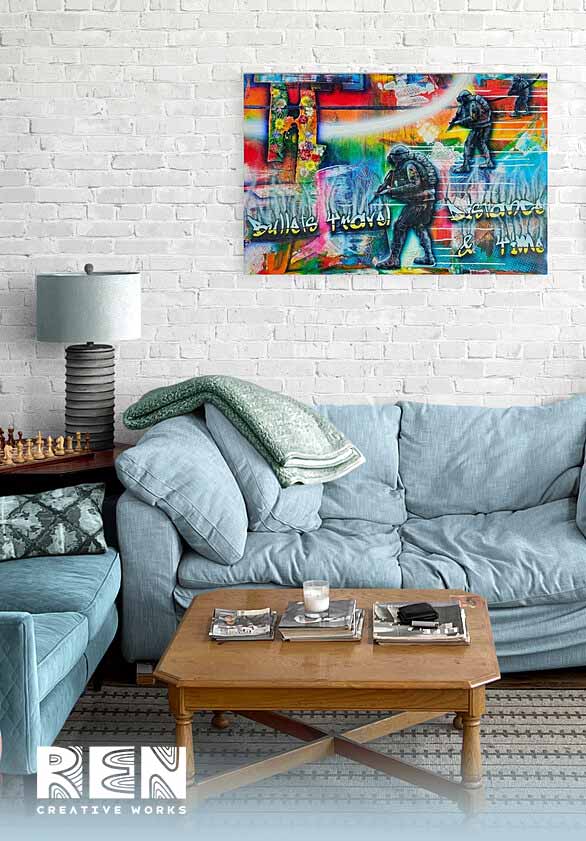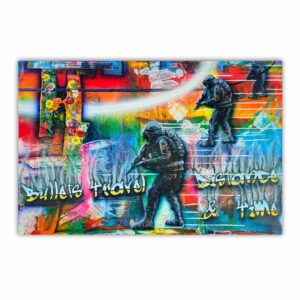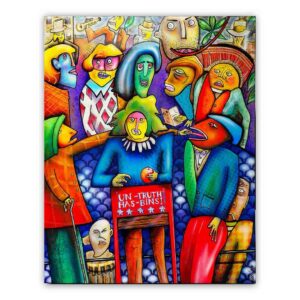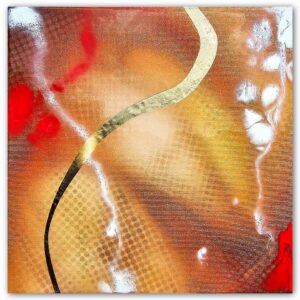- [email protected]
- +353 (0)86 224 0139
- Free Shipping Worldwide
From Mind to Artwork: How Emotions Impact Art
Do you ponder the sonder? Sometimes its difficult to understand what's going on in our own, and other peoples heads. This post attempts to explore how we can express and communicate our emotions through the discipline of Art.
Reading Time: 15 minutes
TL;DR
- Unleash Your Inner Creativity: Learn how to harness your emotions and translate them into captivating artworks that evoke a powerful response.
- Discover the Therapeutic Power of Art: Explore how channelling your emotions into art can provide a cathartic and healing experience, allowing you to express yourself freely.
- Elevate Your Artistic Expression: Gain expert insights and practical tips on techniques to elevate your artwork, enabling you to create pieces that resonate with others and leave a lasting impression.
Art That Evokes Emotions Is Derived From Emotions
How does an artist creatively transfer emotions from mind to artwork?
Art is an expression and response to our emotions; it depicts our innermost thoughts through an aesthetic experience. A person’s innermost feelings are reflected in their art.
Art is a way of looking at life, which is why people with artistic abilities and knowledge tend to be sensitive and insightful.
Art and design have grown in popularity because they are expressive of one’s deepest emotions, thoughts, and feelings. It creates an experience that allows others to gain clarity or connect with the artwork on a deeper level.
By creating these aesthetic experiences, we can appreciate human inventions and artefacts.
Like many diverse forms of artwork, including ceramics, photography, poetry, music, visual arts, and dance, along with natural aesthetics such as mountains, nature, and sunsets.
All of this adds to our appreciation of life and fosters emotional connections with our surroundings.
“...and then, I have nature and art and poetry, and if that is not enough, what is enough?”
Vincent Willem van Gogh
Visual arts draw inspiration from such aesthetic experiences and transform them into art, which is a translation of one’s emotions toward the artform.
Expressing emotions through art is one way for modern artists to extend across multiple contexts. It simply allows the artist to express themselves through contemporary artworks.
Many academics believe that art reflects the emotional side of experiences, implying a connection between pleasure and aesthetic experience.
Aesthetic experiences may be associated with mindfulness because they can increase engagement with an object and give more weight to impressions.
As a result, in order to create art, one must be emotionally involved, and the act of purchasing works of art is a means of expressing one’s emotions.
Mind to Artwork: A Communication of Emotion
Throughout history, artists have learnt how to show emotion in art and use their works to evoke emotions in their audiences.
They have demonstrated that their work can provide a safe space for viewers to explore their thoughts and emotions. They can also be used to educate, inspire, and, most importantly, entertain. As a result, it is not surprising to see the evolution of art in a variety of ways.
Art, almost poetically, channels or evokes emotions that we are all experiencing. When you read a sad story, you may feel sympathy or empathy for the fictional character. Or perhaps the tranquility and calm that comes from watching rain fall from the sky onto a green field. Photographs and poems of good days or happier times do the same thing.
Art that evokes emotions is derived from emotions as well.
“The principle of true art is not to portray, but to evoke.”
Jerzy Kosiński
Art that Expresses Feelings
The beauty of contemporary art in all of its forms is that it has a specific backstory, which some appreciate while others explore their own creativity. You can feel strongly about it and commission an artist to paint it while remaining the mastermind behind it.
Art derives its value from emotional engagement, and you can choose which emotions you want to be represented by artworks.
The modern artist can use feelings and emotions depending on the need and requirement of the artwork. It creates an aesthetic experience that the viewer enjoys. Likewise, art and emotions work together to bring meaning to various artefacts.
The same emotional trigger can be felt by artists and viewers, but it does not have to be the same. A work of art depicting grief can also be interpreted as a symbol of hope. You may evoke that emotion without actually experiencing grief, but you may evoke the concept of mourning and striving for better days. We gain insightful social awareness and empathy for the world around us as a result of this type of idea.
As a result, artwork can depict moods such as joy, rage, hope, happiness, and sadness, as well as the emotion’s relationship to it. For example, listening to sad music can put you in a different frame of mind without actually being sad. The same can be said for motivational songs, which can inspire creative thinking and motivate you before working out.
From Mind to Artefact
The true challenge and skill are channelling your emotions, regardless of the medium. If properly understood, using art to express emotions can produce a positive experience in the recipient as a means of communication.
Depending on the cognitive understanding of the artefact, a better understanding of art can promote the occurrence of aesthetic pleasure.
Emotionalism Art
People frequently associate art with meaning and emotions because artists can use their emotions to create exceptional works of art. All you have to do is associate visual art with your state of mind and emotion, and then let your emotions guide the rest.
Art that Expresses Emotion
Emotionalism is a critical and aesthetic theory of art that emphasises the expressive qualities of art. A work of art must elicit an emotional response from its audience, according to emotional critics. Emotionalists believe that only art that evokes feelings, moods, and emotions in its viewers is worthwhile and valuable.
One of the best-known examples of this art style is The Scream painted by Edvard Munch in 1893.
How an Artist’s Mental State Can Affect the Message in their Work
Munch’s psychological well-being was, in fact, severely disturbed at the time. He suffered from dizziness and agoraphobia as a result of his alcoholism.
Agoraphobia is the fear of being in situations where escape is difficult or where help is unavailable if something goes wrong. Many people believe that agoraphobia is simply a fear of open spaces, but it is a more complicated condition.
The Scream depicts the figure’s extreme fear when they hear a scream, Munch stated; ‘only someone insane could paint this!’
How to Express Emotion In Art
Artistic creation involves not only the artist but also the audience. How do audiences respond to art? Why do they respond to it in certain ways?
The ability of artworks to elicit genuine emotions in audiences is widely believed to be a perfectly natural and straightforward fact. It should go without saying that we can experience fear when viewing menacing monsters in movies, sadness or pity for fictional characters, and joy when listening to upbeat, joyful songs. This could be the main reason why there are so many of us who enjoy art.
Emotions have an impact on both how we perceive art and how it is created. Let us take a look at the role of human emotions in art, as well as the emotional impact created when art is appreciated.
Happiness and Joy
At its core, art is an expression of emotion. From the earliest cave paintings to modern abstract art, artists have struggled to find the right words to describe their feelings.
Fortunately, they have had a lot of success, and their work can convey a wide range of complex emotions. An artist’s emotional state can be clearly seen in their work, ranging from happiness and joy to anger, sadness, and fear.
Art can depict this feeling as a prevailing emotion, regardless of what it means to different people. The art you commission can both hold meaning and bring you joy. As a collector, you are part of the creation of art that can be appreciated by many.
Grief and Sadness
What is sadness, and why do we feel it? As in life emotions can change over time, and how artists respond to negative events in their lives can have a profound effect that can be reflected in their work.
It is not necessary for art to portray sadness for it to demonstrate this specific emotion. Professional artists can do so without compromising on a piece’s integrity. A piece can become a unique portrayal of sadness, perhaps showing the journey to the acceptance of this emotion.
Many people have a harder time with this than with other emotions because it is so difficult to pinpoint exactly what sadness feels like. There is no one way to define the feeling. All emotions are beautiful, and expressing emotions through art adds to their beauty.
Ponder the Sonder
When looking at art, we tend to focus on the artist’s intention and style. But sometimes, the focus should be on the work itself. What does it tell us about the artist? Why did he or she create this specific piece?
As art communicates emotion, it encourages the viewer to realise that everyone has their own unique life and complex pursuits. Understanding someone and transferring their emotions from their mind to artwork can be a fascinating and rewarding experience.
This can be showcased elegantly through commissioning paintings, or admired through other disciplines, such as music, visual or performing arts.
Nostalgia
We all enjoy reminiscing over past events, but with art – you can turn those memories into artworks that you can treasure forever. Emotion and the arts go hand in hand, and nostalgic paintings are a great way to keep a recollection of the event.
Artists have devised a variety of techniques for recreating the event in question. If you have not had the pleasure of attending a sporting event, a painting could be a great way to enjoy it while also showing your support for the team.
Art is a great way to show people that you appreciate their efforts as well. Commission a contemporary artist to bring your favorite memories and emotions to life.
That being said, nostalgia in art could be viewed as a gimmick that causes people to like your art more than they should because it is familiar.
Furthermore, nostalgic elements can highlight cultural malaise and have a positive impact when it empowers a new generation to self-awareness and realisation.
Symbolism to Convey Emotion
The interpretation of symbolism is one of the most fascinating and complex issues in art criticism. In art, the use of symbolism can be extremely effective in depicting specific emotions or communicating a specific message to the viewer.
However, the perception of symbolism is also subjective, and not all viewers may agree on the intended meaning behind a work of art.
It is not uncommon for contemporary artists to use symbolism in their aesthetic expressions to convey emotion. For example, in the 1973 film “The Exorcist,” director William Friedkin used swirling colours to represent his characters’ psychological states.
Transferring one’s emotions from mind to artwork, regardless of medium, can take a variety of forms.
Colour to Express Emotion
Emotions can help us make sense of our surroundings and make our lives more enjoyable. Artists have used colour to express emotion throughout history, thanks to their understanding of colour.
Warm colors, such as red, yellow, and orange, can evoke a wide range of emotions, from comfort and warmth to hostility and anger. Cool colours like green, blue, and purple can evoke both calm and sadness.
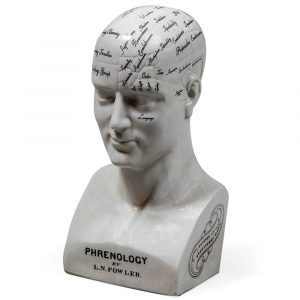
Conclusion: Why Emotions Matter in Art
An artwork is not only a thing that exists in space, but it is also an experience that we share with the artist. In order to understand what art is, we have to understand what an artist means when they say that they are expressing their emotions through their art.
From childhood to adulthood a story can be told through art, and its meaning lies within the emotional connection that we develop with the artist and their work.
Express Your Emotions Through Art
Ren Creative Works can help you build a masterpiece that is fuelled by your emotions while evoking them in your audience.
We offer a bespoke service to craft your most beautiful emotions from your mind to artwork, and provide tailored services that speak volumes by itself. We are committed to listen to your story, imagine the vision and bring it to life. If you wish to ponder to sonder further, tap into your emotional intelligence and contact me today for more details.
If you enjoyed this article, please show your support by subscribing to my mailing list and sharing it with your network! As an independent artist, your support means the world to me. Your time is valuable, and I appreciate you taking the time to read my blog.
Don’t miss out on future articles and updates – subscribe now and stay connected!
Searching for Completeness
We all strive for completeness in one way or another. Add a touch of sophistication to your space with art.
Adrian Reynolds, or ‘Ren,’ is a Dublin-based contemporary artist. His works are a reaction to the world around us. A world that continues to evolve quicker than ever. His work investigates colour, form, and texture, putting them at the intersection of abstraction and representation. His art has been shown in Ireland, the United Kingdom, and the United States.
Latest Artwork
-
Bullets Travel Distance & Time
Abstract Art Paintings €1,000.00Add to basketBullets Travel Distance & Time | Acrylic Painting By Adrian Reynolds
-
The Perception of Narrative
Abstract Art Paintings €800.00Add to basketThe Perception of Narrative | Fine Art Acrylic Painting By Adrian Reynolds
-
Iridescent Dream
Abstract Art Paintings €240.00Add to basketIridescent Dream | Acrylic Painting By Adrian Reynolds
-
Blue Nebula
Abstract Art Paintings €240.00Add to basketBlue Nebula | Acrylic Painting By Adrian Reynolds


